How Two Teenagers Started a $70,000 Dropshipping Store Under Lockdown
With the world economy in uncharted waters, this may not seem like the most opportune moment to take risks – not least of all to start a business.
But that's not a vision shared by two ambitious Aussie teens.
Lachie and Taylor saw a chance to run an experimental dropshipping store to sell non-medical items as the world went on lockdown and they took it.
The result? Their store made $70,000 in one month.
In this episode of Start Yours, these teenage entrepreneurs join us to tell us all about how they launched their ecommerce dropshipping store in under three hours, the tests they carried out, their customer service techniques, and how they embraced past failures to succeed.
We hope you enjoy the podcast! If you do, please consider subscribing.
Short on time? We've got you covered. Here's a five-point TL;DR version:
- Lachie and Taylor face a lot of stigma because of their age. Most people think if they can be successful at a young age, others can too.
- Anticipating logistical delays, they created a fictitious customer service representative that is based on their target demographic to increase relatability.
- With an initial goal of $1,000 a day, they eventually made $70,000 in a 28-day period, which is equal to $2,500 a day.
- Dropshipping is first a hobby, then a side hustle, and then an income replacement.
- When learning about dropshipping from YouTube, pay attention to the similarities people say because there's probably some truth in them.
Start Yours is a podcast about ecommerce, dropshipping, and all things launching a business.
Join us as we meet entrepreneurs who have gone through the triumphs and headaches of running an online store, and learn how they managed to survive and thrive.



The Stigmas of Being Successful Teenagers
Aleisha: You are 18 and 19 years old. Tell me about how other people react when you say, “Hey, we just made a lot of money during the COVID crisis.”
→ Click Here to Launch Your Online Business with Shopify
Taylor: I guess the first thing is we don’t really.
Lachie: I don’t put numbers out there. I don’t portray any numbers.
Taylor: I will try not to.
Lachie: Yeah.
Taylor: I mean, it’s a weird sort of space this is because you sort of have to put your numbers out there for credibility.
Lachie: Social proof.
Taylor: This is sort of a time where the only people that really see our numbers are people that are interested in sort of the ecommerce stuff from our Instagrams and our LinkedIn and stuff like that. But like when talking to family members and friends and stuff like that, when they ask about it, that’s…
Lachie: It’s an attraction when they know that at 18 and 19 that we can do this. It’s like, “Okay, well if you can do it at 18 and 19, I can do it at 30. I can do it at 40.”
It’s like, “If you idiots can do it, anybody can.”
But there’s a lot more to it than that and more times than not. It’s just, even the people that asked me and associate my age with success and if we can do it, they can do it. I don’t even give ’em the time of day talking to them about this, it’s just not the right reason to get into dropshipping or entrepreneurship.
Taylor: I guess a lot of people wanna get into this because financially… Like, it looks easy if young people can make a good amount of money doing that. They think it looks attractive and it looks, “You know what I’m 35, I’ve got years on these kids. I could out-school them,” and then they’ll give up after a week when their first Facebook ad doesn’t work.
So it’s been a weird time, I guess, for Lachie and I having to tell friends and family to sort of, “Look this isn’t probably the right thing for you.”
Lachie: I’ve been doing it for a long time. Like, turning people down for a long time. Even school friends I used to go to school with. Same thing with Taylor when he went to university, even the people, like, even our closest friends I can tell you have asked to get into the space because they’ve seen the success.
And like for the last few years, I haven’t put anything out publicly so they haven’t known of all the hardship and everything else in between and then immediately when they see the green light and the numbers and the positivity that comes out of entrepreneurship, they immediately try and get into it and that is just, “No wrong reasons, back away.”
Taylor: Yeah, I guess it’s the people that do dropshipping because they wanna build something, they wanna start a business, they wanna do something bigger than working nine-to-five. Those are the people that I guess will stick with it long term and actually have some success with it.
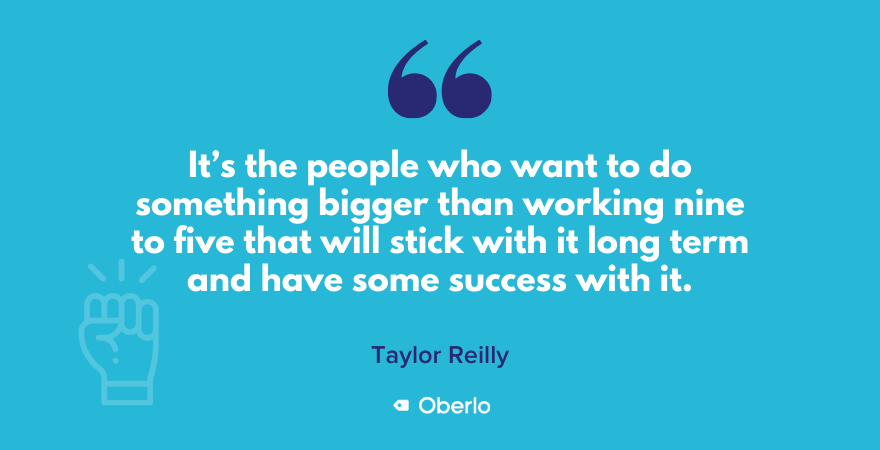
Aleisha: You mentioned that throughout high school, people were asking and you were doing this. So when did you both feel that entrepreneurial itch? When did you both think, “Oh, I don’t wanna go and do your standard nine-to-five. I wanna run my own business and do my own thing”?
Taylor: I know for both of us. It’s always been like that.
Lauchie: I know, yeah, it’s been through Minecraft, I guess in the early days like 11-12…
Taylor: We both wanted to run Minecraft servers, we both, I remember when I was in primary school I was selling scooter parts.
Lachie: I was selling, believe it or not, as bad as it sounds, I was reselling rocks out of the garden in year two.
I was trying to create my own rugby ball in grade three. I wanted to do some, like, microphone and some chip that when you kick the ball it comes back to you in grade thee, of course, I didn’t have the funding or the cash flow at that time but it could come soon.
Taylor: Yeah. I know when I started getting into coding and sort of the end of high school, I came up… It was me trying to come up with apps and all that sort of stuff that went through that phase. So like it’s always been there. But I guess once I found out about dropshipping, that was sort of the outlet to sort of really explore that.
Lachie: Yeah. Go all in.
Aleisha: You mentioned that people assume and I suppose this happens in so many industries that you don’t see all of the shit that happens in-between the success.
Lachie: Yeah, spot on.
Perseverance Is Key
Aleisha: And then people assume that it’s easy or you’ve had a really free ride coming into things. What is the advice that you can give to new business people that are starting yours that are really about to jump into the world of business?
What’s the first bit of advice if I came to you and said Lachie and Taylor, I wanna get into this. How do I start? And how do I also not feel defeated when it all doesn’t happen?
Lachie: Well, the first thing assumption is that… My number one… What I realized over the last 12 months, people who assume or when you assume or overthink, that is the worst that… It is my biggest pet peeve and personally in business and success, every time I’ve over-thought or assumed something wasn’t gonna work or just went to that area, I never got anything done.
Taylor: The best piece of advice I could probably give for someone you’re getting into this is: expect to fail. Very few people, if anyone, strikes gold the first time.
You’ve sort of just gotta to keep digging until you sort of get in the clear and you have something that’s working and then you just sort of have to build upon it.
No one’s first story is great. I mean, look, some… You could get a golden ticket and have someone with an amazing first store. But generally, 99.99 percent of people’s first store will suck. They’ll be selling watches, or jewelry, or fashion, like all the things that I know everyone has done and they don’t work anymore.
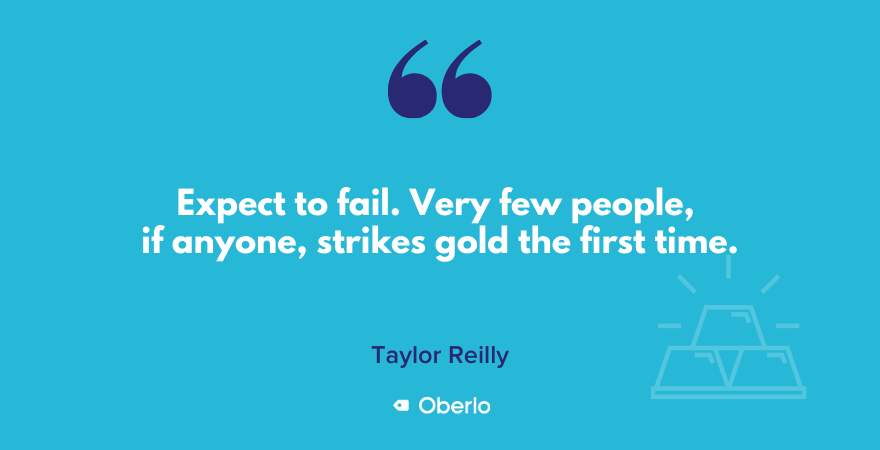
Lachie: What I’ve noticed over the last 12 months is the difference between the people that get into it maybe for the right or wrong intentions bottom line. But the people who come out on the other end, or the people who are in it for many years are the people that have those failures and bounce back and learn from those failures.
So many people… We’ve got, we’re in a lot of contact with people between the ages of 16 to 20 odd here in Australia and the thing is, every time they come to us and their Facebook ad that’s been live for 12 hours hasn’t made a sale, or they’ve come to a roadblock and haven’t been able to pivot and they back out. They don’t come back from that.
The people who learn from that and then bounce straight back into it learn from their mistakes. They are the ones that come in on the other side.
Taylor: Which, to be honest, it’s understandable. And I guess this is sort of like a good outlet to chat about it. In this space, there’s a lot of false news with people selling their overpriced courses that are built in 2017. There’s a lot of outdated knowledge as well.
And so with the people with the Lamborghinis and their luxury items and then the flexing that like, “Oh yeah, you just sign up, pay my $2,000 course and you’ll be rich next week.” It makes it seem like dropshipping is easier than it is. We both agree that it’s kind of unethical, pretty unethical.
Developing the “Dropshipping Eye”
Aleisha: It’s not a quick fix situation where you can jump in, and you have to put the work in, which is why I’m so interested in sharing your story. You guys are hustlers. But you also are really good at spotting opportunities.
And when COVID hit, you made a quick decision and it’s actually paid off really well for you. Let’s talk about when you came together, and when this could be an opportunity and ran with it.
Taylor: Okay, so first off, like we both knew, just like when there’s a big trend when there’s Christmas or Black Friday, everyone knows you’ve gotta find the latest trend to sell at this time and I guess, Lachie and I knew like with COVID, there’s a lot of stuff going on, there’s definitely going…
Lachie: A lot of people are gonna be at home.
Taylor: Well that was the first connection we made. But we knew there would be stuff trending and of course, like you search up the obvious: the face masks, the hand sanitizer. And to be honest, the number of influencers we’ve seen over the last month or two come up with their own brand of face masks, and I think I saw a few influencers, like, do it with free plus shipping and tell their audiences, “We are given out masks completely free, good of my heart.” And I mean like…
Aleisha: Shipping is $45.
Taylor: Like that was pretty unethical. So I mean, trying to find a product that didn’t hurt people and like medically, like masks, hand sanitizer, things people need. It would have been so easy to find a supplier for a mask, get it made up, put a cool design on there and then dropship it but then there’s a whole ethical conflict. But that’s when Lachie and I started looking into what you would find when you’re at home, like what are people gonna need?
Aleisha: Tell me about where you were looking? Where’s your “go-to” space to find?
Taylor: Google Trends.
Aleisha: Google Trends?
Lachie: Google Trends. And Facebook, organic search as well. Just having a scroll through seeing what other people do and watching that. Do you know what I mean?
Aleisha: Great, and this is basic free stuff that people can do right now. You can go and sit there. There’s no expense and you don’t have to do anything.
Taylor: Yeah, I like to always call it the “dropshipping eye”. You really need to develop the eye to know, “Okay, this is something I need to look into further.”
The only thing I didn’t really attribute to the success of this store was the amount of failure Lachie and I have had in knowing these are shit products. We know what doesn’t work. And so we also knew, looking at a Google Trends graph, we know we can break it down by location, we can break it down by the spike, and we can sort of figure out why there was a spike there. Is it COVID-related? Is it not COVID-related? And then that’s sort of how we broke it down.
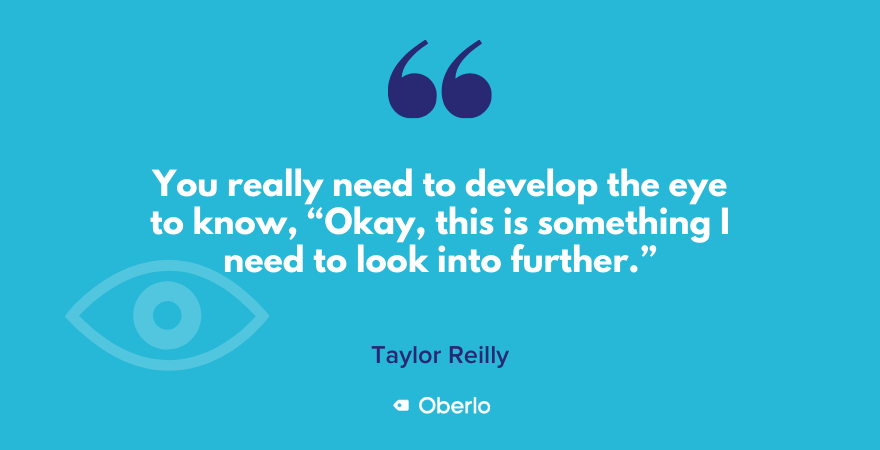
Aleisha: So we’re not gonna talk specifically about the product because you wanna hold on to that and I totally get that. So we are gonna say that it’s something you can use at home. It’s in the gaming world.
Taylor: Craft, yeah.
Aleisha: And it’s fun for the whole family. You went to Google Trends, you found the item and then how quickly after you did that search, did you both come together, and say, “This is it, we’re gonna hit the button?”
Lachie: It was Friday night, straight along.
Taylor: I was in bed watching Netflix as a usual Friday night and I got a FaceTime call from Lachie. It’s like the text message. I missed the call from him and then the text message was just, “Let’s go.”
Lachie: And Taylor and I smashed it out that night, got it all up.
In probably two and a half hours, everything was up.
At about probably 1:30, 2 AM knock-off, ads were up, page created, everything fully built, the store created, all the products, everything live, all the variants and yeah, we were on.
Aleisha: Let’s go through the steps then to let everybody know what that actually means.
Step-By-Step of Starting a Dropshipping Store
Lachie: First things first was… Immediately, the biggest issues that I knew going into selling a product in relation to coronavirus and COVID were going to be were shipping times and store design.
So first things first, I knew what product we were selling to suss out suppliers. I messaged every single supplier I could find for the product or variants of on AliExpress, I messaged them on AliExpress, and straight away tried to get them on WhatsApp.
Now, I know my ratio of replies was horrible. I had suppliers leaving me on red. But I had one guy, and the guy we’ve worked with from day one to now replied to me straight away, I got him on WhatsApp and basically vetted him from there.
We started talking, getting as much proof as I can, learning that he was legitimate, looking at his store reviews, but taking him also off AliExpress and onto WhatsApp where I would talk to him and message him actively every single day and I still do. And then from there, store design, getting into building the store.
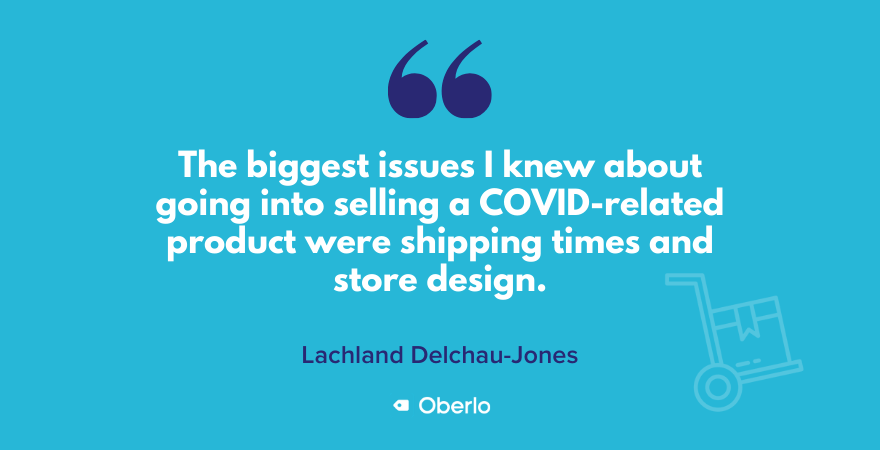
Building Trust With Your Store
Taylor: Yeah, so Lachie and I know how to build a one-product store. We know what you need there, we know what works and what doesn’t work. But we knew this store would have to be different. So was it Oberlo that dropped the article or Shopify about the traffic in ecommerce? It increased by like 400 percent or something crazy.
Lachie: Yeah, it was 400.
Taylor: So we knew we had to have a store that looked really good, looked impressive, looked trustworthy, looked like we wanted to own this product and so we really…
Lachie: Really whipped it up.
Taylor: We whipped it up. I think we did a pretty good job.
Lachie: Built it as trustworthy as we could. Made it as trustworthy as we can. Color schemes, trust badges, and everything in between.
Taylor: Logo. Yeah, all in one night.
Aleisha: Let’s break that down then because what do you see, and how can we communicate what trust is when you’re building a store, what does that actually mean?
Lachie: Simplicity.
Taylor: Transparency.
Lachie: You want it to be as transparent as possible. We just wanted to get people from coming off the ads onto the website. I simply put that I want them to see the price, I want them to know exactly what this is. And I want them to get to check out with no loading issues, no things that could distract them. I just want them to get straight through the sales funnel.
Research Your Target Demographic
Aleisha: So you’ve created the store, you’ve looked at the design, you’ve made it really minimalistic, simple and ready to get the sale. Did you think about your target audience and who you were selling this product to on that Friday night?
Taylor: So one of my product criteria actually is trying to visualize the demographic and I talk about this a lot.
When I say visualize, I’m talking about it being related to someone you went to school with, a family member, a friend, I wanna know where they hang out.
Lachie: Anything, yeah.
Taylor: Who they hang out with, what are their hobbies, so I can use them all as different interests when I’m starting on Facebook. Lachie and I thought we had that. We were like, “Yeah, yeah, we know it. We’re in the clear.” Very quickly, we found out that we were close, but there was like… People were buying for completely different reasons…
Lachie: Wrong reason, yeah.
Taylor: For what we thought. Your 30-year-old mom with two kids, they’re probably five to eight, she’s working from home, and she needs to distract the kids during the day. That’s what we thought and then it worked. I’d say it worked.
Lachie: It worked. I think we made a couple of grand with it.
Taylor: Yeah, but then as we were sort of narrowing and looking at our data and our insights, we realized that the demographic was actually a lot older than what we had anticipated, and it had nothing to do with the children.
‘Cause originally my… Lachie and my goal was to take advantage of the fact that kids were home from school. I thought we were spot on with everything we had, but it turns out people weren’t buying for the kids, they were buying for themselves.
Aleisha: So this is a good pivot.
Decide on Your Marketing Platform
Lachie: Exactly. And another thing on that Friday night, I went to Taylor and we immediately brainstormed, really quickly, the ideal demographic and really quickly, I jumped straight to Facebook. I thought Facebook would be our golden nugget, like, Facebook placements, strictly Facebook placements. Taylor’s kinda… He pushed in real quick suggested Instagram.
Taylor: I’m like, “No, no, no Instagram’s where we’re going. We’re out of that placement,” and Lachie said, “What? Instagram? Mom’s don’t use Insta.”
Lachie: I know. And we started…
Taylor: I’m like, “Dude.”
Lachie: Exactly. And we started… And this was really good ’cause this was a Friday night, Saturday, so very early this was well before we can start narrowing down, I go, “Screw it. Let’s do both.” I think in the end Instagram…
Taylor: Of course, start broad, yeah.
Lachie: Yeah, start as broad as we can. Instagram ended up generating 60…
Taylor: 30 plus thousand.
Lachie: 60 to 40. Yeah. 60 to 40 to Instagram in the end, in terms of our revenue.
Taylor: It did at least, I would say, 30 to 40 thousand dollars through Instagram, over the month.
Setting Financial Goals
Aleisha: What was your goal when it came to launching this store? You had the conversation on that Friday night. Did you set financial goals, do you have timelines?
Taylor: Okay, yeah. So this is actually interesting, Lachie goes to me, and he goes, “Taylor, I know this will work. I wanna be making a thousand dollars a day by Monday. I think we can do it. I know that goal’s a bit out of reach, but I think we could be doing it.”
Lachie: Fresh product, fresh pixel, fresh demographic.
Taylor: We had done over easily $10,000 by that Monday. Back to goals, as well. I guess the biggest thing was I know my family through the 2008 recession got hit hard and I knew we’re definitely gonna go through a massive recession because of the Coronavirus.
And I guess, Lachie and I have only been old enough now to really understand a recession and what happened.
So my first instinct, and it has been like this for the last couple of months, was I think consumer spending might go down and because losing jobs, less income, so and so. But I guess with all the bailouts that came, especially in Australia, people had income. Yeah, so…
Lachie: It’s just like Q4, this period has been just like Q4 and over Christmas time, which has been awesome for everyone in the dropshipping space and everyone that’s in the dropshipping space is well aware of how awesome the consumer’s spending has been.
Taylor: So I guess it was a goal for us to really see if we put our two heads together and really tried our best to see if we could make it during probably the toughest time we’ve had in a century.
Lachie: Spot on.
Taylor: Yeah.
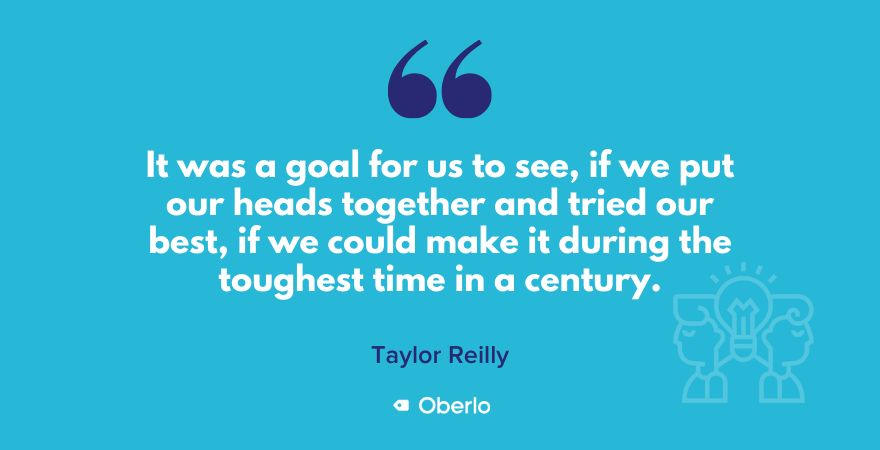
Lachie: Building something fresh, that was another reason. We’ve got a small platform on Instagram where we can prove to little kids, we can prove to 16 to 20-year-olds here in Australia and go, “Hey look, we are able to build this.”
If we can do this, starting on Easter weekend and launching and running, doing $12,000 over Easter weekend on this brand new store, as well as launching during Coronavirus with the shipping times, which are a massive turn off for people and we can do this and get this going.
Aleisha: So when you launched the store, what was your goal, and what did you end up making in that one month?
Talyor: So the goal was to do…
Lachie: A thousand bucks a day.
Taylor: A thousand bucks a day.
Lachie: It scaled very quickly.
Taylor: So in the best-case scenario, we thought we were gonna do one, even get this to $1,000 a day.
We did $70,000 over the course of 28 days.
We missed the first week of where we should have been selling, as well.
Lachie: We should have been selling for a week earlier. But we also had days that sales were down because Facebook ad accounts were banned. We had days that we had to turn off payment gateways and test that. We had everything that could have gone wrong with the store, went wrong, and that somehow affected us one way or another, but we managed to combat that.
The Facebook ad account was down on a Saturday. I think we did just like maybe $1,200, then on a Sunday, we did $5,600 so it’s pure pivoting, and that’s one thing that we noticed that we are really, really good at is being able to pivot and learn from the stuff that goes wrong then and there and fix it. Whether it’s at 3 AM or 3 PM, we’ll fix it.
Taylor: So $70,000 over just a month…
Lachie: Yeah, about a month.
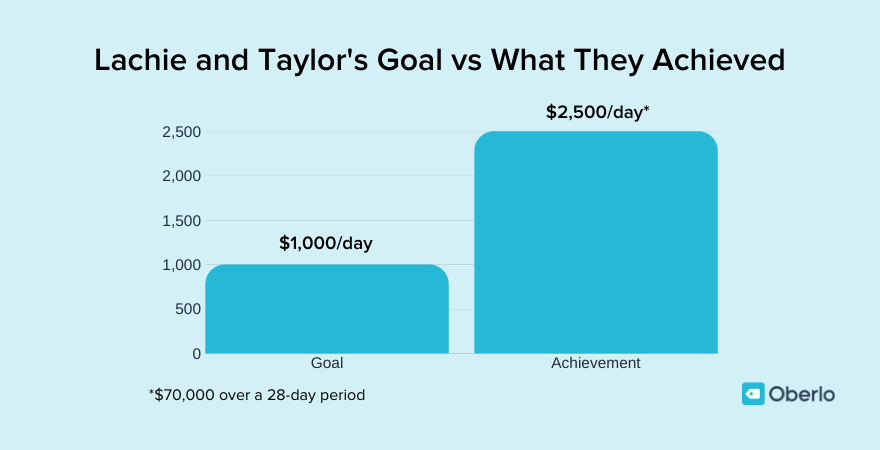
Taylor: Yeah. Do you wanna know about profit margins?
Aleisha: Yeah, let’s talk about profit margins. Yeah, come on.
Lachie: Yeah, break them down.
Taylor: When Lachie and I were running… The first week of the store, and this is nuts, unheard of.
Lachie: One and a half weeks. One and a half weeks.
Taylor: Yeah, be generous. Rocking 60 to 70 percent profit margins. Obviously, as most people know, as you scale, your margins go down. And obviously, as we went through the quarantine the demand started to drop as restriction started to… Talk of restrictions easing up happened.
Lachie: We’re testing a few things during this time as well.
Taylor: Yeah, so I think we did about $20,000 profit in the end, something close to that.
Lachie: Just over that, yeah. So that demand just simply went down.
Creative Customer Service Communication
Aleisha: Let’s talk about customer service, then. You mentioned timelines. Obviously, these are, as everyone says, unprecedented times. Things are pretty out of our hands when it comes to our daily lives, but also running businesses.
So when it comes to launching a business, you’ve got the trust with your supplier, but then also we have to trust that the shipping, the freighting companies are gonna do what they said they’re gonna do. Now, that’s something. But also you have to communicate and keep your customers happy. Let’s talk about how that happened.
Taylor: Aleisha. You would be shocked, shocked about the number of people that would message us and go, “There is no reason, at all, for delays.”
Aleisha: Really?
Taylor: At all and…
Lachie: Yeah, you’d be surprised.
Taylor: And my reply was, always, “Look, we’re doing our best. We fulfilled your order. Here’s a tracking number. There are hundreds of thousands of people that have died. Millions that have caught this killer virus. Could you please understand that there is some delay?” And she goes, “Fine, still not good enough, though.” I’m like…
Lachie: So one way that we decided to combat this, now, really quickly to preface:
We did not outsource any of this store, this store is our little Coronavirus project. It went for exactly a month, this was our work.
So we knew our demographic was slightly older women here in Australia, and signing off an email that I get that is obviously from the customer, and saying, “Kindest regards, Lochland”, “Kindest regards, Taylor”. That wouldn’t win 100 percent of the time. So what we came out with really quickly…
Taylor: I don’t think it’s smart to drop the name of our customer support, right? She was a lovely lady. Let’s just say we made our customer service representative, and…
Lachie: Our demographic.
Taylor: Our demographic identically. The person who we knew was the person buying our puzzles, that was our service rep.
The Fictitious Customer Service Representative
Aleisha: Let’s just call her Sheryl.
Taylor: We can call her Sheryl.
Lachie: Sheryl works. I’m just worried about one of our customers listening to this podcast and going, “Those kids!” But no, we thought really quickly that if we’re working… How we are gonna win them over is by making the customer service rep the customer. The exact same demographic.
What we found out… We thought, “Okay, they’ll have no issue.” But yeah, they can relate to Sheryl and they can go, “Oh look, I understand Sheryl.” They’re gonna be nice to Sheryl, they’re not gonna go…
Taylor: They’re not gonna be nice to Lachie and Taylor.
Lachie: They’ll abuse Lachie and Taylor, they won’t abuse Sheryl.
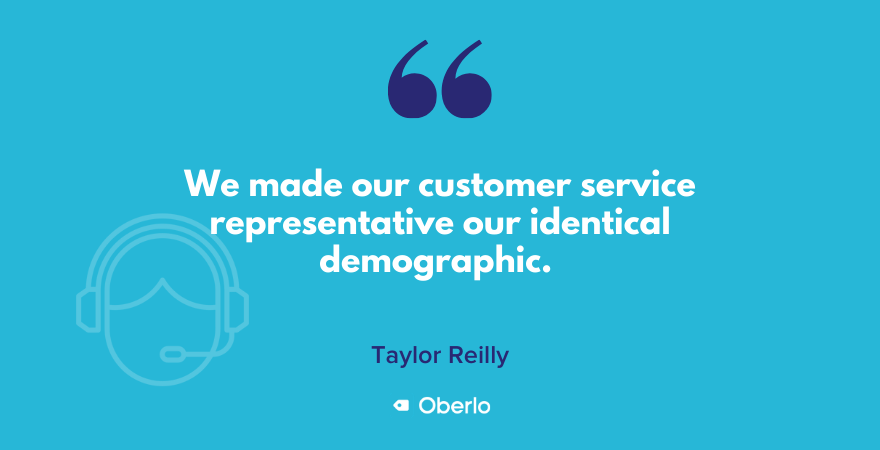
Aleisha: Interesting. And did you… So, you changed your tone when you were communicating ’cause it was you. Did you change the tone?
Taylor: We changed everything on the email account. We had a signature.
Lachie: We had a signature. We had a profile picture for her.
Aleisha: Okay wait, tell me about the profile picture.
Lachie: Yeah. Tell her about the profile picture.
Taylor: The profile picture I’d like to think was my little spark of creativity. Obviously you don’t wanna steal someone’s face.
Aleisha: No.
Taylor: That’s terrible, that’s wrong. So there’s a website which basically generates faces that don’t exist using an AI tag, it just merges stuff and comes up with a person that doesn’t exist. And you can keep refreshing the website, and it gives you a new random person that isn’t a real person, every single time. And we finally found someone.
Lachie: About an hour later.
Taylor: We’re talking orange, bushy hair, like, mid-50, yeah, yellow smile.
Lachie: They loved her. Everyone loved Sheryl.
Taylor: There were so many, “Thank you so much Sheryl, I understand. Hope you have… Hope you’re staying safe during these times.”
Lachie: “Have a great weekend. No rush replying back to my email.”
Aleisha: Oh wow. So, now the website you’re talking about is called thispersondoesnotexist, is that right?
Taylor: I think that’s what it’s called yeah, thispersondoesnotexist.com, yeah. So yeah, that was when we thought that it was a good idea.
Lachie: Normally, it doesn’t really go… As I said, Taylor and I are involved in every single aspect of this ’cause it’s our little project. So the thing is… And we knew, during these times, that no matter what, there are shipping delays. We don’t have time to go through and source an agent, we don’t have time to do any of that, so we just had to work with what we have.
Every day, we’ve got packages still arriving into the country, we’ve got tracking numbers, we’ve got everything. But we knew at the end of the day that customers weren’t gonna be happy with that.
We knew the demographic, they were gonna complain. So we just made sure that our customer service representative was going to be able to make the situation as smooth as possible.
Taylor: And, yeah, I guess the thing is, it’s very hard to not argue with these people over email. You’ve gotta come off very professional.
Lachie: Yeah. I can imagine a lot of people probably listening to this, right now, are in the boat of Taylor and I’s mindset through this project and that was, “We wanna be involved in every aspect.” And that’s what it comes to. Before you can outsource any of this or before you can train or hire anybody to do the customer service work, you’ve gotta get in there yourself and it’s one of those things that is signing off with your name, or your full name. Just taking that into consideration, because at the end of the day, we know…
Taylor: I just didn’t wanna get doxed, really.
Lachie: Yeah. And we also know that customers aren’t gonna keep coming back. This is a Coronavirus store. This product could be relevant in the next few months. So let’s just make the customer’s experience as good as it can be. We don’t need them to come back a second time, even though people did.
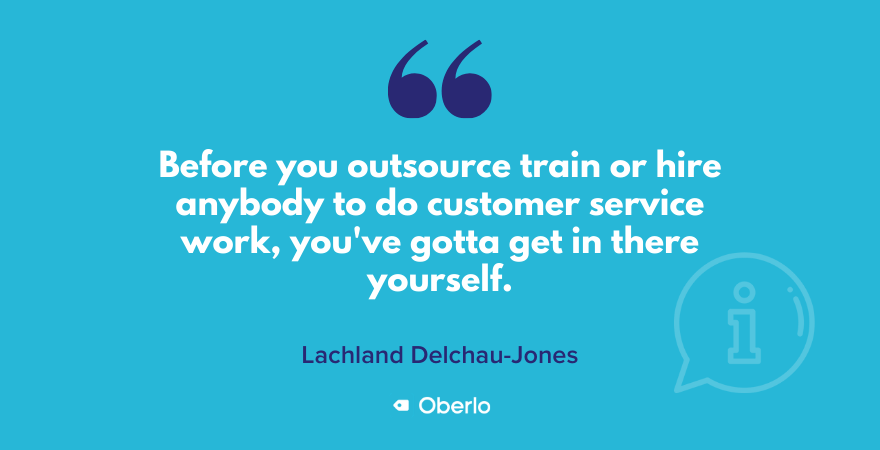
Working With Friends
Aleisha: I’m really interested in your friendship or working with friends ’cause I think sometimes this can go really well for people and other times, that can be a bomb. How does it work with you guys?
Taylor: I would wanna 100 percent agree on that. I have tried to do stuff with friends before. Lachie has as well. It doesn’t work. That’s friends wanting to start something together I think. And same with family. I guess it’s different.
Lachie and I both became friends through doing stuff like this, even talking about what we were doing when we were younger like both trying to start up our own little ventures and stuff like that, that obviously all flopped.
We come from very similar places so we get along very well.
Lachie: Yeah, I know that, especially, going through school, you don’t have those business connections or you don’t have those like-minded business people, especially in the school scene. I just left it, I know.
So the common go-to is that if I’m gonna build something, how can I save money on this? I’m gonna plan it with a friend. Let’s go, 50-50. Or, my friend wants to do this. At the end of the day, where a lot of kids I know go wrong and where I’ve gone wrong in the past a few years back, was that people don’t have the same drive as you. I know we work with people on the daily that have drives in different areas, whether it be sports, academics…
Taylor: Music.
Lachie: Whether be music, but I know where my drive lies and it’s not inside any of those areas. So yes, they may be able to bring value to you here. But they’re not in it for the long game. I know I can play this game for as long as I wanna play. I can be in the dropshipping scene for as long as I wanna be because I know that I don’t have a reason to leave, and I know that I’ve got the drive to stay in it and keep trying to do it better and better and better.
Taylor: I think, and it’s worked really well Lachie and I working together, especially really closely over the last sort of six months and we both have had the same goals. We’ve partnered up on a lot of different ventures together but we sort of both know that working together, we’re gonna get to where we wanna be quicker ’cause I know either of us could have done this all by ourselves and it would have done… Probably flopped.
We both carried each other in certain areas and that I think I definitely attribute to the success of it.
Finding Success Through Failure
Aleisha: I really like that you mentioned success and failures, and you are very transparent about saying that you’ve dipped the toe into ventures that weren’t necessarily successful, but then I also think the success that you are achieving now can come from those failures. Tell me more about the experiences that you’ve had.
Lachie: I know like personally, how I learned Facebook ads was completely trial and error.
Taylor: Oh yeah, same.
Lachie: You put money into Facebook ads, that’s another area where people drop off, they put money into Facebook ads, it doesn’t work, they drop off they never do it again. When I know the only way you can lose money and I still do it to this day, everyone runs an ad set that isn’t profitable. Everyone does. And it’s one of those…
Taylor: Oh yeah. Even on your first round, you should expect 80 percent of your ads to be unprofitable. Even you even get like… If you’re running 10 ad sets and two of them are profitable and working well, those are the two you narrow down on.
Lachie: Exactly.
Taylor: But most people go, “Argh, two of my things worked, eight of them flopped. Let’s give up on this.”
Lachie: Yeah. But it’s one of those things I know that if any day or when I was starting and what I encourage people to have that mindset is the only way you can lose money with a Facebook Ad is by not collecting or using any of the data you learn from it or the experience.
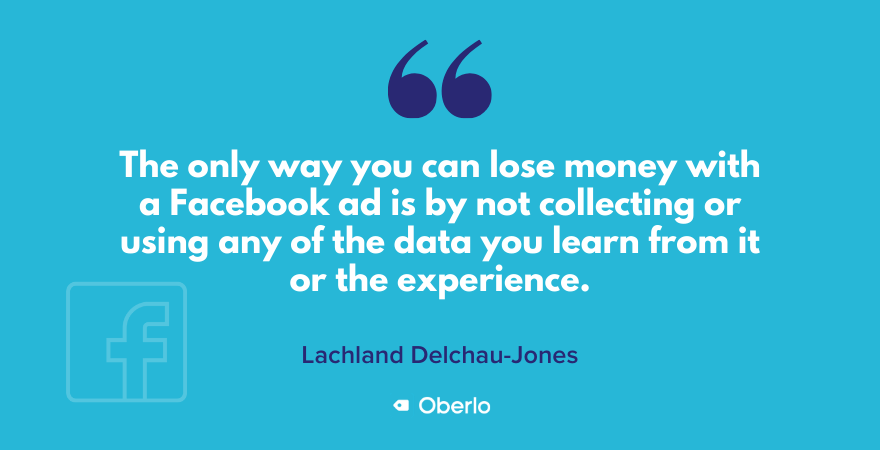
Taylor: Yeah. I guess back to your question, in terms of failures, we’ve all had dropshipping stores that have completely flopped. And I make… That’s a fact, that’s a fact of this business I guess.
Lachie: Everyone has.
Taylor: I know I’ve whipped up stores as I did for this one in a night, I’m going, “Yeah, this is the product, this is the winner of the year.” And then, it turns out that I’m the only one that thinks like that, and then I move on. But that’s just part of the game. You just gotta do your best to vet a product, figure out if it’s working.
Lachie: And trust in your gut on it as well.
Taylor: Yeah. If it flops, move on, don’t be emotional with it. And yeah.
Lachie: I know, for example, I know one of my first products that really kicked off a few years back was a phone case. It was just a simple phone case and I knew that phone cases were a very very stupid thing to get into. It’s a phone case. There are a lot of different phone case variants, everything in between, but like, on that, I trusted my gut, and it ended up working out for me, but it was one of those things that did not happen overnight.
Taylor: Speaking of phone cases, this is just a side plot. For one of those stores we talked about, I whipped up a store a couple of months back. It never initiated, I never turned the checkout on, I didn’t accept payment and just left it out. And I thought, “You know, this is cool.” And I was gonna do something and got distracted with it.
And then I started getting emails from the account like the other week, like a week ago of people like, “I’m trying to buy it.” I’ve never run an ad to this thing. People are like, “I’m trying to buy it, it’s not letting me checkout.”
I’m like, Okay. I thought like one person’s found the site through the 10th page of Google. And I turn on the checkout and at the end… The store, since I’ve turned the checkout on, I haven’t run an ad on that store. It’s done $2000 or something.
Lachie: Australian. Like 1,000 USD. And it’s pure SEO. When Taylor showed me it, he literally whipped it up one night, left it there. And then people are finding it on Google or through Shopify.
Taylor: I went on the story yesterday, it’s like 30 people on at the one time.
Lachie: Yeah.
Taylor: Like I think it did yesterday, it did a 1000 US dollars yesterday. I haven’t run an ad on it.
Aleisha: So, how many stores are you guys running at once? Like, tell me about your inventories.
Lachie: Of course. Collectively, we’ve got two, two going at the moment, we’re working on a third that we’re gonna probably get up live before Wednesday. I’ve got one separate running. In terms of dropshipping, you know it’s very, kinda, “get in, get out”. That store where I was just talking about that phone case, I still have that to this day. It still does a comfortable just shy of $1,000 a week. That just goes in the background.
Taylor: A lot of the stuff I was working on personally, I’ve turned off all my ads for that during this period ’cause it’s just not working. So I guess that’s something I’ve put on pause while we focused on this store.
Getting Into Dropshipping
Aleisha: Let’s just talk about risk. You guys just said the obvious, you guys are young and you seem very open to being advantageous with your options and choices when it comes to building businesses.
What’s some advice you have for people that might be a bit older or they’ve got their 9 to 5 and they want to take the leap into running an online store whether it be dropshipping of creating their own product?
Taylor: I know it’s the same… Same for Lachie and it’s the same for me. The people that are gonna stick with this long term, I know I’ve worked 9 to 5 jobs, Lachie has.
If you’re the type of person that is miserable there and this is something you’re debating, take the leap, get started, spend your nights working on something like this.
Lachie: It can be a great start for you, it may put you on a great path. You learn a hell lot from it, but it’s not one of those things I would go, “Hey, quit your job and go all in one.”
Taylor: Dropshipping is a hobby first, then a side hustle and then an income replacement.
Lachie: Yeah. So like, for example, I used my hours before at lunch and after school and on the train to work, to work on my stores. It’s my part-time job.
Taylor and I are very fortunate to be able to do this full time now, but it’s one of those things that was never full-time. You’ve just gotta make your priorities aligned with where you wanna go.
Taylor: For people that are looking to get into this, accept that there will be failure, pick yourself up, and just give it your all. Just actually put in the effort. You can’t fake it, you can’t just say like, “I put in half an hour here, I’m done for the night.” It’s… Put in as much effort as you can give that day, and you’ll see the success from that.
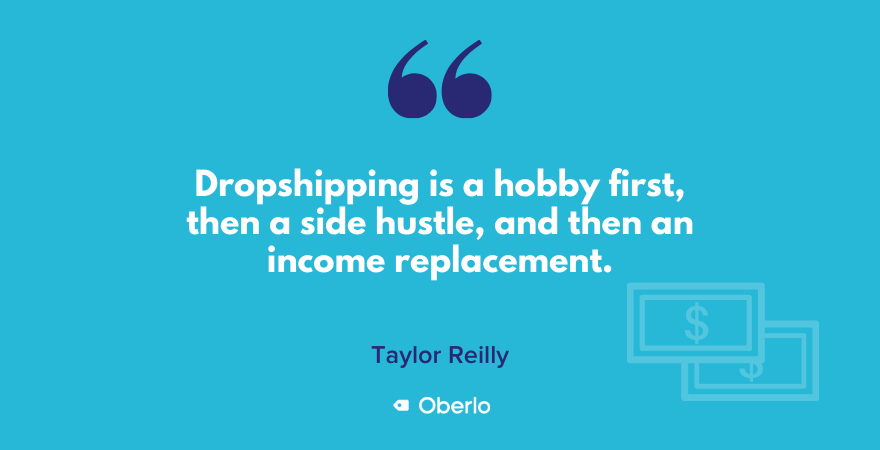
Aleisha: What’s the one thing that you think everyone should watch or read or listen to or subscribe to when it comes to building your own business?
Taylor: Okay, so one, all of Oberlo’s blog posts. Two, and this is a thing I’m very, very passionate about is with all the bro-talk in this scene, learn through YouTube. You don’t need to pay a $2,000 course.
If you’re gonna learn through YouTube, watch as many different people as you can and write down the… They all say different things, but they’ll all say a few things that are exactly the same, and those… That’s the stuff that is real in that.
Lachie: Yeah. Take your two cents from everything.
Taylor: Yes, exactly.
Lachie: Making your own strategy if you want to but just yeah.
Taylor: Expect to fail, learn that you have to be able to test stuff in this space, and binge content. Like watch everything in this space that you can and just make sure that you don’t listen to the bro-talk, you avoid it, you’re aware of it and…
Lachie: That’s really important to be aware of.
Taylor: Very important.
Lachie: Aware of it.
Taylor: And just look for the similarities between what everyone’s saying. If everyone’s saying that you should be spending this much on an ad set a day when you start now, then there’s probably some truth to that.
Aleisha: Awesome. Now, if people wanna get in touch or follow what you’re doing, not necessarily specifically with this store, but also you’ve mentioned your Instagram, where can we do a little bird stalking?
Lachie: @LachieDJ on Instagram. L-A-C-H-I-E-D-J.
Taylor: @TaylorBReilly. T-A-Y-L-O-R-B-R-E-I-L-L-Y. I couldn’t get handle just @TaylorReilly. There’s a YouTuber in the United States with like 400,000 followers who’d stolen that from me.
Lachie: Stole your name.
Aleisha: Hey Taylor, and Lachie, thank you so much and I’m really looking forward to seeing what you launch in the future, and thanks so much for sharing your insights with the Start Yours audience.
Lachie: No worries. Thanks for having us on. It’s been awesome. Really appreciate it.
Taylor: No worries. Appreciate it. Yeah.
Lachie: Oh jinx.


